This easy beef fried rice uses a bold seasoning of chili and cumin. It requires very little prep and only takes 10 minutes to cook. A one-pan dish that’s satisfying enough to serve as a main for dinner, or packed into your lunch box for meal-prep, or can be served as a fancy side for your Chinese dinner party. {Gluten-Free adaptable}
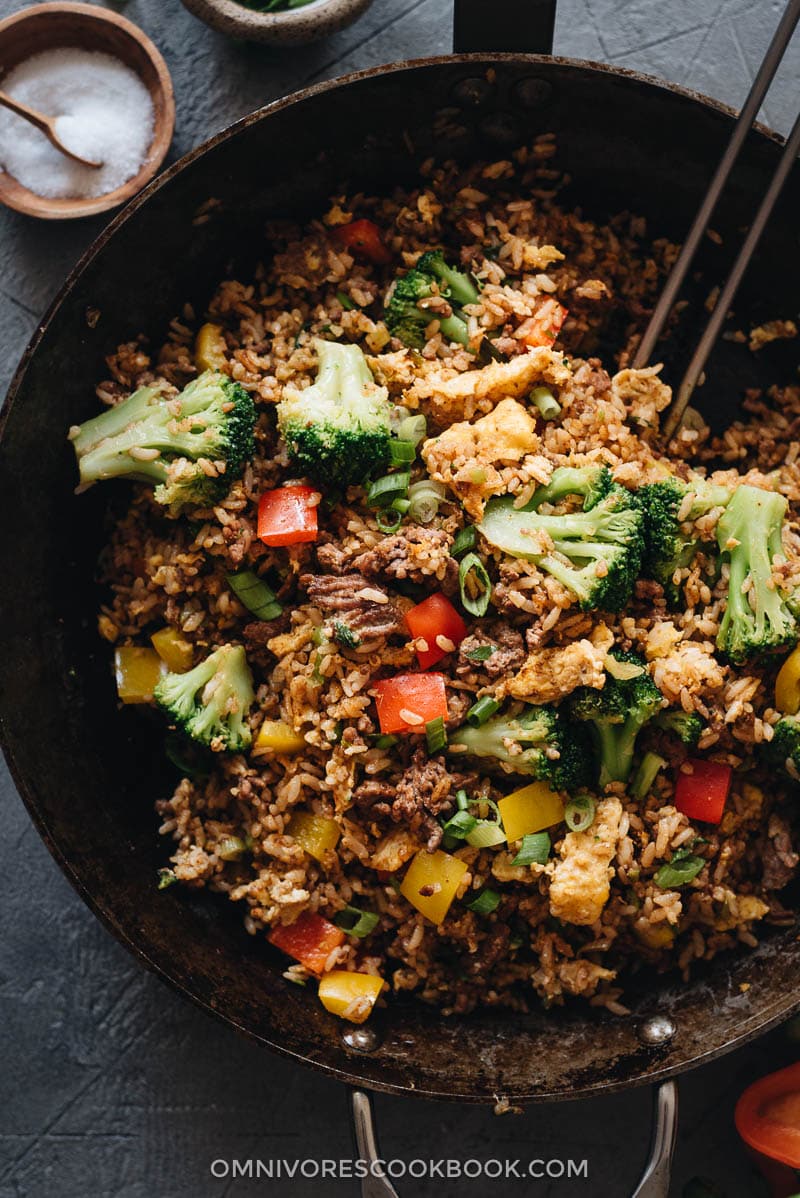
Growing up in China, I have a special bond with fried rice. It is something I can and want to eat at any time of the day. I’ve lost count but I think I have more than 10 fried rice recipes on my blog. And it’s still not enough! From simple recipes such as 3-Ingredient Egg Fried Rice, Soy Sauce Fried Rice, and Shrimp Fried Rice, to fancier Pineapple Fried Rice and Jambalaya Fried Rice. I keep making them and finding new ways to create delicious flavors.
For me, there’s one common element in all of my fried rice dishes. That is, the recipe has to be simple and very easy to make. Because the goal of fried rice is to use leftovers and whatever you have on hand to make a quick and satisfying meal.
Today I want to share my favorite beef fried rice recipe. It uses a flavor combo that’s commonly used in Xinjiang cuisine – cumin and chili pepper – with a touch of soy sauce. You’d be surprised how these simple ingredients can create such a bold aroma.
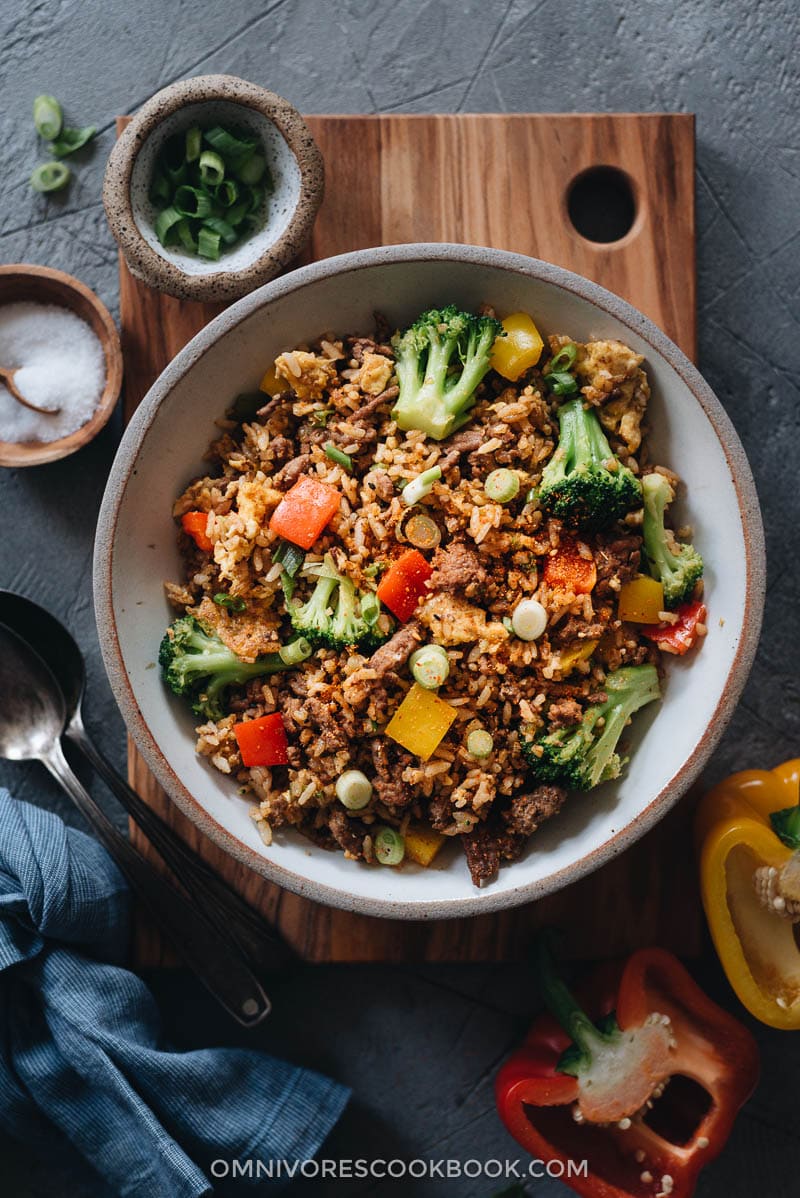
Cooking notes
1. Why I prefer ground beef
Sliced or diced beef might seem like a great option for beef fried rice. And yes, it does give the dish a more appetizing look. But when it comes to fried rice, I always use ground meat. The advantages of ground meat are:
- It doesn’t require any prep. No slicing or marinating needed.
- You won’t overcook it by leaving it in the pan. Unlike sliced beef, which usually requires removal from the pan during the cooking to prevent it from overcooking.
- It tastes amazing with cheap ingredients. Because ground meat releases more flavor into the dish than sliced meat, it adds tons of umami to your rice.
My trick for cooking ground beef is to keep some bigger bits without separating the meat into tiny flakes. It adds amazing texture to the dish and it feels like you’re eating a burger when you bite into the bigger pieces.
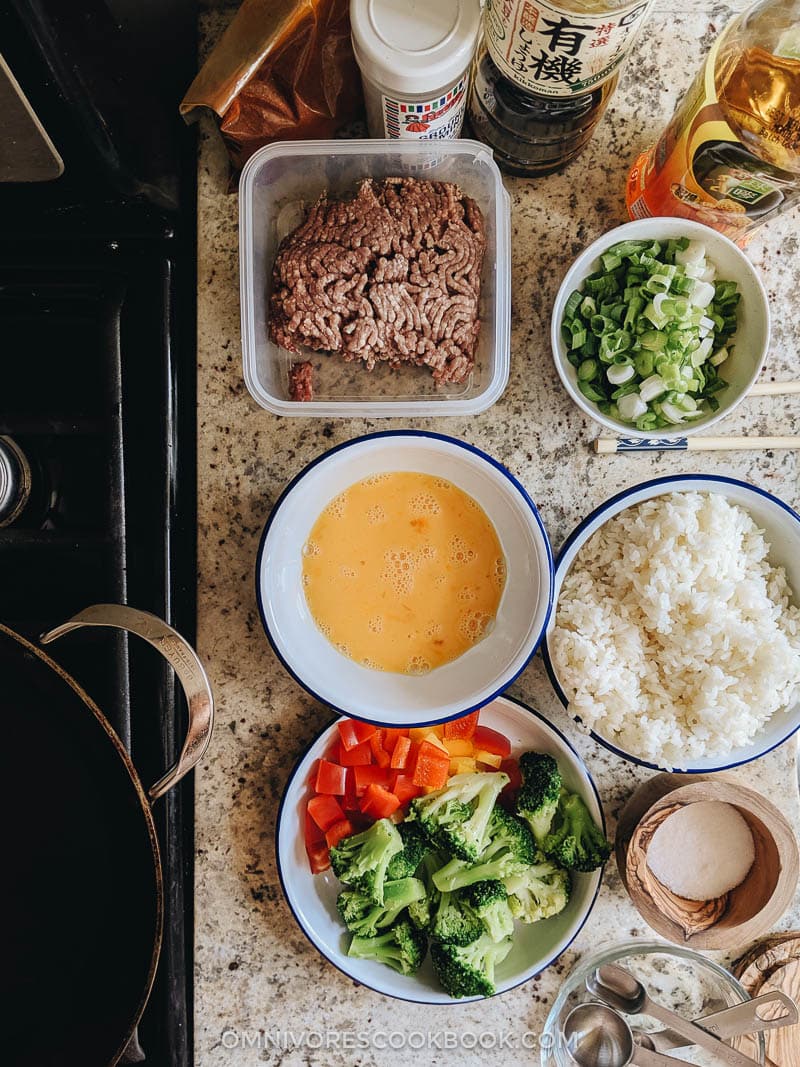
2. A word on cookware
I’ve discussed in the past why NOT to use a wok, and some of the best ways to set up your stir-fry station if you’re using an electric stove. Long story short, the most convenient setup is to use your electric stove (or a typical home gas stove) with a large pan, such as the 12” Calphalon deep fry pan or 12” Debuyer Carbon Steel Pan. Both provide enough surface area against the heating element to heat up your pan well, while they’re also deep enough to hold the ingredients during cooking.
The benefit of using a nonstick pan is that you can use less oil without the food sticking to the pan. That happens a lot when you cook starchy foods such as fried rice. On the other hand, I do prefer my heavier carbon steel pan when it comes to fried rice, to give the rice a better char. Like cast iron pan, carbon steel pan becomes quite nonstick once well seasoned. However, in this case, you will need to add a bit more oil to prevent the rice from sticking.
3. How to make better fried rice
Believe it or not, the trick to making better fried rice is to stir it less. It seems contradictory to the concept of a stir-fried dish, doesn’t it? The truth is, when you make fried rice, you should let the rice sit on the hot pan long enough to create a crispy char. This is even truer when using a nonstick pan. Always use high heat and make sure the pan is hot (without burning the food) when frying rice. It makes a big difference.
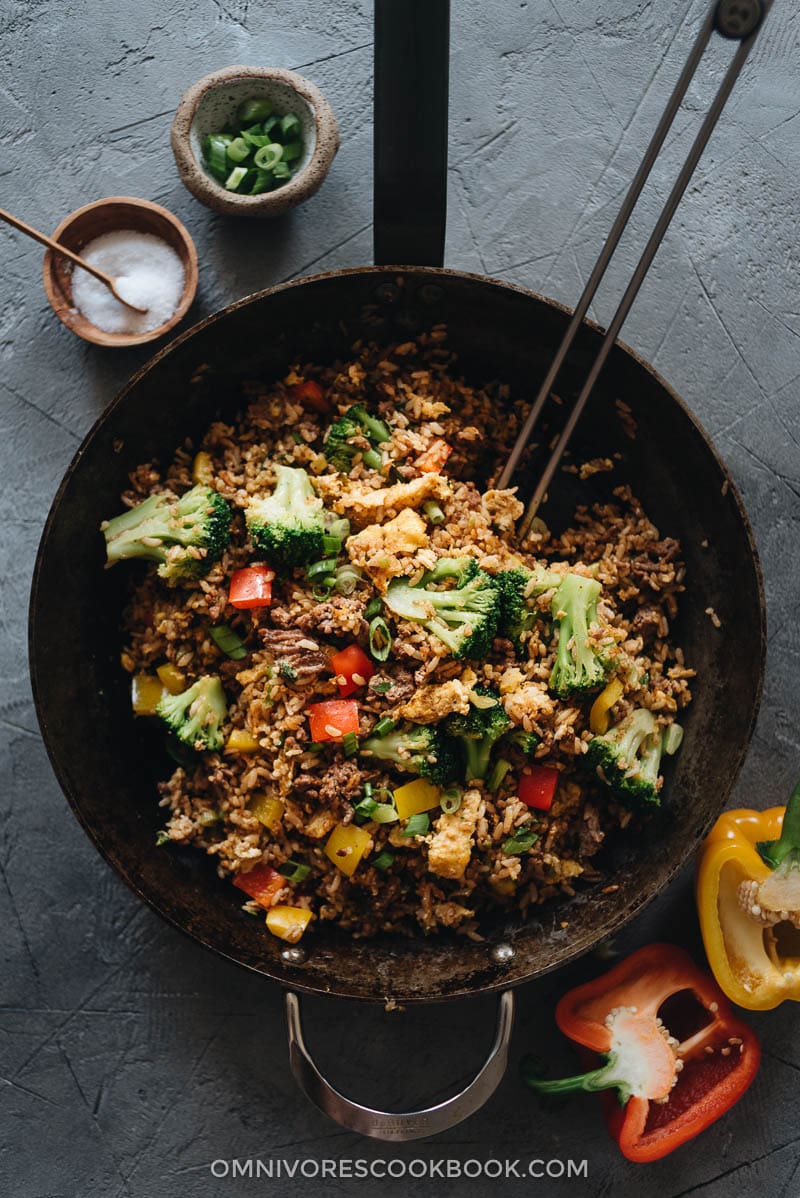
4. Do I have to use leftover rice?
You probably often see fried rice recipes call for leftover rice or “overnight rice”. I probably did the same thing in some of my recipes. It is right and wrong at the same time. It means you should use cooked rice that has been stored in the fridge for a day or two to make fried rice.
The reason for this requirement is, once the rice is chilled and stored in a cold environment for a while, it will become less starchy. So the rice will separate during cooking without sticking together. It yields a better texture and mouthfeel.
On the other hand, it does not mean that you cannot use fresh rice to cook this dish. It happens to me often, that I crave some fried rice but I don’t have any leftover rice on hand.
In this case, you can simply make steamed rice. It’s even better if your rice cooker comes with a “hard” texture setting. Once the rice is done, spread it onto a plate so it will cool off faster. Then transfer the rice into the fridge and let it sit there until you’re ready to cook. The rice will still be a bit starchy, but you won’t notice a big difference.
Storage
Beef fried rice keeps well in the fridge. I love to make it in advance and save it for later. It’s a great dish to make for meal-prep and dinner parties because it reheats well.
That’s it! I hope you enjoy this beef fried rice recipe as much as I do. Happy cooking!
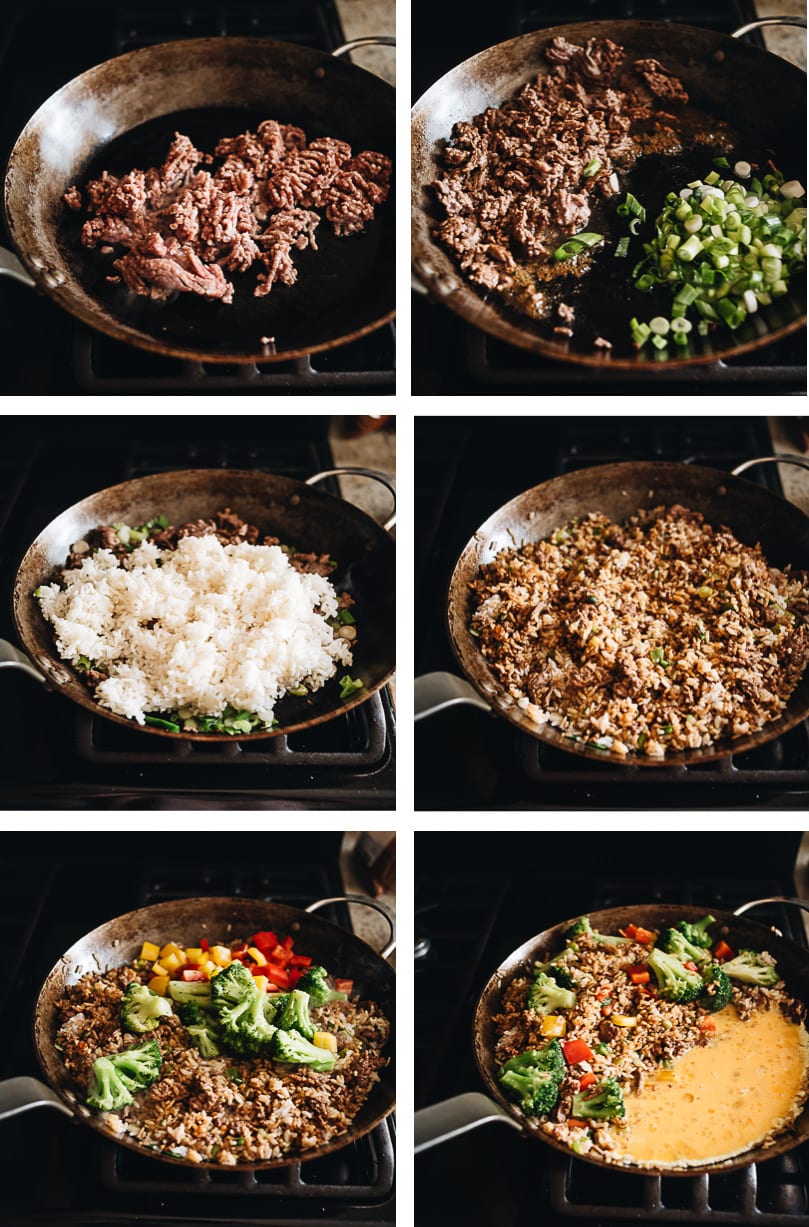
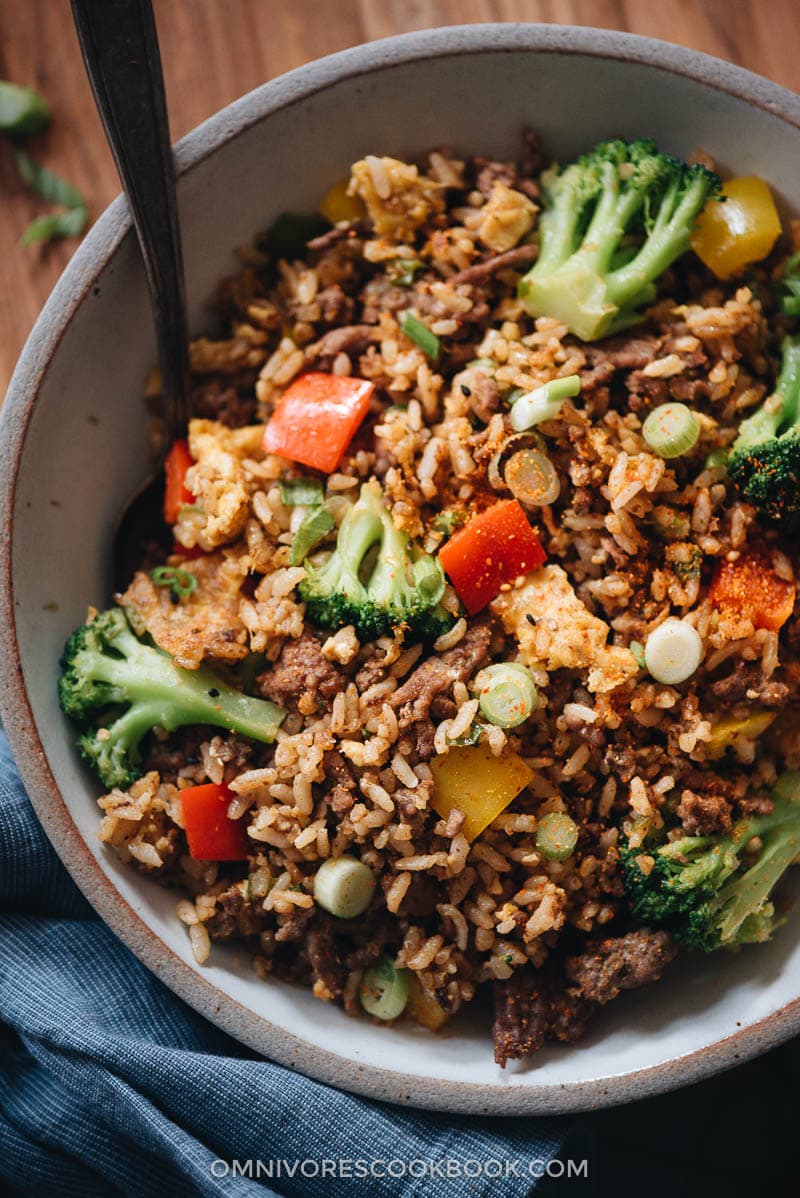
More fried rice recipes
- Vegetable Fried Rice (蔬菜炒饭)
- Peking Duck Fried Rice
- Easy Kimchi Fried Rice
- Potato Fried Rice (土豆炒饭)
- Thai Curry Chicken Fried Rice
If you give this recipe a try, let us know! Leave a comment, rate it (once you’ve tried it), and take a picture and tag it @omnivorescookbook on Instagram! I’d love to see what you come up with.
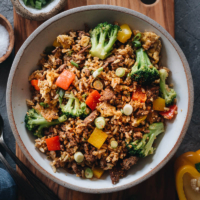
Easy Beef Fried Rice (牛肉炒饭)
Ingredients
- 2 tablespoons peanut oil (or vegetable oil)
- 1/2 lb (225 g) ground beef
- 2 tablespoons soy sauce , separated
- 3 eggs , beaten
- 4 green onions , chopped
- 3 cups cooked rice , chilled
- 1 cup frozen veggies (broccoli, carrot, corn, and/or peas)
- 1 bell pepper , diced
- 2 teaspoons cumin powder
- 1/2 teaspoon chili flakes (or powder)
- 1/2 teaspoon salt (or to taste)
Instructions
- Heat 1 tablespoon oil in a large nonstick (or carbon steel pan over medium-high heat until hot. Add the ground beef and quickly spread it across the pan with your spatula to form a thin layer. Let the bottom cook until browned, 2 to 3 minutes. Drizzle with soy sauce. Flip the beef and chop it into smaller pieces with your spatula. When the beef is almost cooked through, move it to one side of the pan.
- Add the remaining 1/2 tablespoon of oil and green onions onto the empty side of the pan. Stir a few times.
- Add the rice and pour the remaining 1 tablespoon of soy sauce over the rice. Stir and cook for 30 seconds until evenly mixed. Stir everything together.
- Add the frozen veggies, bell pepper, cumin powder, chili flakes, and sprinkle with the salt. Stir and cook for a minute. Move everything to one side of the pan.
- Add 1/2 tablespoon of oil onto the other side of the pan. Add the beaten eggs onto the oil. Let them cook for a few seconds until the bottom sets. Scramble the eggs using your spatula, cut them into smaller pieces, and mix them with everything else.
- Transfer everything to a plate and serve hot as a main or side dish. Enjoy!
Nutrition
The original recipe was published by Dec. 4, 2014 and updated on July 28, 2019. My previous recipe uses cooked (leftover) beef and this version uses ground beef with added veggies.
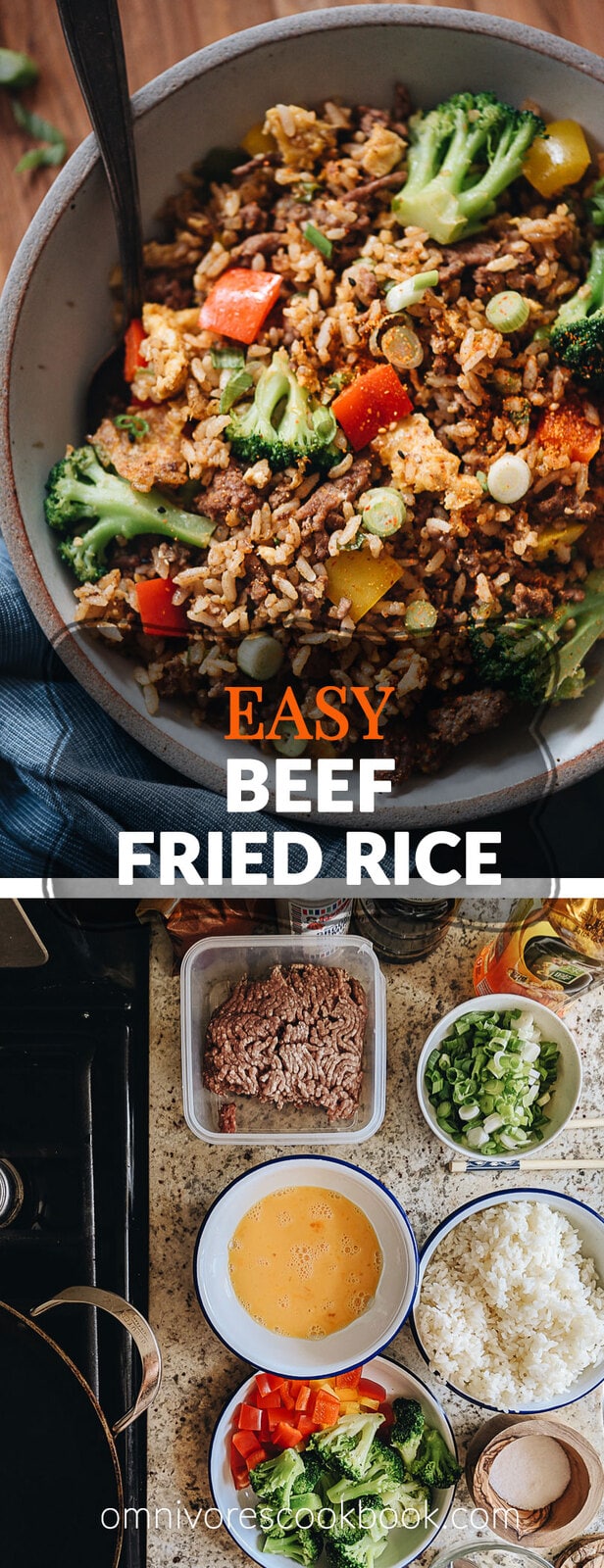













This is so something I could eat every day for the rest of my life:)
YUM. Looks soooo good. Will make for dinner this week! 🙂
Love mongolian beef (it’s always the first thing that I order when getting takeout.. ), never made it myself before though! This is definitely something I need to try!
What a fabulous tip to use leftover meat fat for cooking. I love that idea! Here in the UK duck fat is considered to be the best for cooking roast potatoes … and it really is. It’s so tasty. Would love to try the rice. What’s not to love about making an easy dish super tasty? 🙂
I adore Mongolian beef. If it is on a menu, I always select it. Thanks for an entremely informative article!
You are my hero of the day Maggie. This is DIVINE and I can’t wait to make it!
Okay, now this sounds like a dish I would love. I love the simplicity of the recipe and your photos are GORGEOUS, per the norm. 🙂
This looks amazing and I always have extra white rice. Could I do this with left over chicken thigh meat? I am a Nagi FAN 😉 YAY Nagi!! and use lots of chicken thighs in my recipes. I could even boil a boneless piece of thigh if that would be better. We do not eat a lot of red meat, not that we do not enjoy it, but we seem to eat chicken, pork, lamb etc. more often.- OH I could use pork? Excited about your blog, and will be trying a few new dishes for 2015. (cooking meat in oil and sugar!) THX, Lisa
Hi Lisa, thanks for stopping by! Of course you can use leftover chicken thigh (including boiled one) or pork in this recipe, it will be super delicious too! I used beef because that’s what I had at hands the other day. Yep, I’m a big fan of chicken thighs too. Here in China, we consume more pork and chicken and other meat, so I had quite a collections of these recipes. Hope you can find what you like here and happy cooking! 🙂
Maggie
A great recipe! I agree with you about using minced meat, and about leaving it in bigger chunks. I’m going to try this recipe with chicken mince.
Great pictures, great explanations. Love your recipes!
Awesome…….and I must have the green bean recipe akso.
Tasty! Loved the cumin and chili that gave it a kick.
Followed your instructions and it came out great.
Remembered the frozen peas and carrots
Forgot the broccoli
Tomorrow we’ll finish the fried rice with the leftover stew beef and potatoes.
this was so good, not super expensive to make at all which is awesome when you only work a minimum wage job, but ill definitely be making this again
Hi Maggie
Thanks for this lovely recipe. I can’t wait to try it!
However, I do have one question. When I cook with minced beef, I notice that instead of getting browned, it tends to be watery after sometime in the pan. Is it because there isn’t enough oil in the pan? However, you put only 1 tbsp of oil and that isn’t much too.
Wonder if you could provide some tips on this. Thanks
If you start to see water / juice seeping out, it’s because your pan is not hot enough, so the beef start to steam instead of searing.
A few things might help: use a larger pan, heat the pan longer until very hot before adding the meat, and / or cook the meat in small batches.
If you crowd the pan with too much meat and the temperature is low, the meat will start seeping out juice instead of browning and sealing the juice in. Sometimes even when you heat up the pan very hot, this might still happen because once you add the meat, it drops the pan temperature dramatically and it might take some time to heat back up.
If it happens again, what you can do is to remove some of the meat (or all of them) from the pan, so the pan will heat up again. Then you can add the meat back without the juice, which helps with the browning.
Does any kind of rice work with this recipe? I always have used long grain, but lately have been making short grain and wondered if it would work just as well?
My favorite type of rice for fried rice is medium grain, but long and short grain work as well.
When you use short grains, the rice can be a bit stickier, so the grains might not separate as well than the medium/long grains.
What you can do is to make sure the leftover rice is a bit dried out (they dry out more when you store them in the fridge for more than 1 day). Before the stir fry, you can also use your hands to separate the rice, which helps too.
Thank you! I just went ahead and made it with my leftover rice after asking the question. I called it short grain, because I didn’t look at the package. It is the Calrose Medium grain! Anyway, it was delicious, and actually found that I prefer the texture to the long grain! Now this is on my list of recipes to make when I have leftover rice! Or will just make the rice, so we can have it for dinner!
I’m glad to hear you liked the dish! And happy that you discovered the medium grain rice. I think it works better in stir fried rice because the grains separate easily. Unlike long grain, they don’t fall apart during the stir fry, and retain some chewiness.
Thanks for leaving a great review 🙂